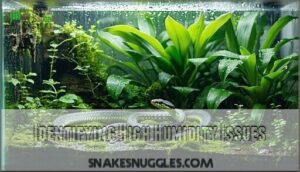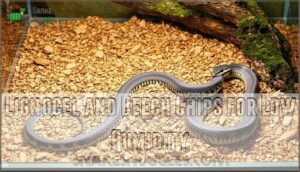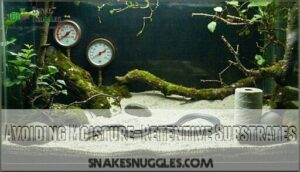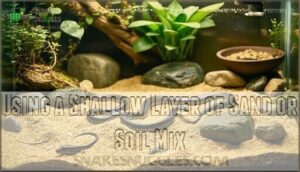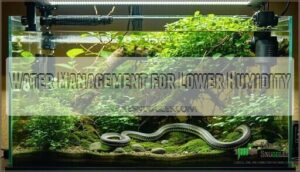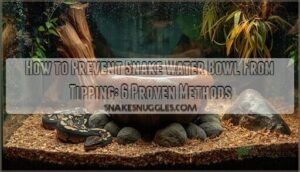This site is supported by our readers. We may earn a commission, at no cost to you, if you purchase through links.

You can monitor levels using digital hygrometers placed at substrate level for accurate readings. To reduce humidity, use incandescent bulbs instead of heat mats, place smaller water bowls at the cool end, and improve ventilation.
For increasing humidity, use wider water bowls or add room humidifiers. Poor humidity control leads to respiratory infections, stuck sheds, and scale rot.
Getting these levels right requires understanding your specific snake’s natural habitat needs and the hidden factors that can make or break your setup, including proper snake tank maintenance, accurate readings, and avoiding respiratory infections.
Table Of Contents
- Key Takeaways
- Snake Tank Humidity Levels
- Identifying High Humidity Issues
- Choosing The Right Substrate
- Reducing Humidity With Lighting and Heating
- Water Management for Lower Humidity
- Monitoring and Maintaining Optimal Humidity
- Humidity Levels for Different Snake Species
- Emergency Humidity Reduction Methods
- Natural Methods to Raise Humidity
- Maintaining a Healthy Humidity Balance
- Frequently Asked Questions (FAQs)
- How much humidity does a snake need?
- How do I maintain humidity in my snake tank?
- How do you know if a snake has a high humidity?
- What happens if the humidity in a snake tank is too high?
- What is the Best Substrate for Lowering Humidity in a Snake Tank?
- How Often Should You Check the Humidity in the Tank?
- What Are the Health Risks of Having Too Low Humidity in a Snake Tank?
- Are There Any Natural Methods to Raise Humidity in a Snake Tank?
- What Are the Signs of Too Much Humidity in a Snake Tank?
- How humid should a snake tank be?
- Conclusion
Key Takeaways
- Know your snake’s specific humidity needs – Ball pythons need 50-60%, corn snakes thrive at 40-50%, and green tree pythons require 70-80%, so you cannot use a one-size-fits-all approach
- Monitor at substrate level with digital hygrometers – You will get accurate readings where your snake actually lives, and digital units provide ±2% accuracy compared to analog’s ±10% error rate
- Control humidity through strategic water and substrate choices – You can reduce levels by using smaller water bowls at the cool end and low-moisture substrates like lignocel, or increase humidity with wider bowls and moisture-retaining substrates
- Watch for health warning signs from improper humidity – You will see respiratory infections, scale rot, and stuck sheds from high humidity, or dehydration and breathing difficulties from low humidity levels
Snake Tank Humidity Levels
Maintaining proper humidity levels in your snake’s tank directly impacts their health, affecting everything from successful shedding to respiratory function.
Different snake species require specific humidity ranges, with factors like substrate choice, heating methods, and ventilation all playing key roles in creating the ideal environment.
Humidity Requirements for Different Snake Species
Different snake species have vastly different humidity requirements based on their natural habitats.
Ball Python needs 50-60% humidity, while Corn Snake thrives at 40-50%. Green Tree pythons require higher levels at 70-80%, and Boa Constrictor prefers 50-70%. King Snake does well with 40-60% humidity.
Understanding your snake species’ specific humidity preferences prevents health issues like respiratory infections and shedding problems, which is crucial for maintaining the well-being of your snake species.
Factors Affecting Humidity in Snake Tanks
Understanding snake tank humidity starts with knowing what affects it. Tank size impacts how moisture circulates, while substrate depth determines water retention capacity. Your heating setup creates temperature gradients that influence evaporation rates.
Maintaining proper snake humidity levels involves understanding the importance of humidity control systems.
Key factors affecting snake humidity include:
- Ventilation strategies – Airflow patterns control moisture buildup and circulation
- Water source placement – Bowl location affects evaporation and humidity distribution
- Tank size – Larger enclosures maintain more stable humidity levels
- Substrate depth – Deeper layers hold more moisture for longer periods
- Temperature gradients – Heat differentials drive air movement and water evaporation
Importance of Monitoring Humidity Levels
Tracking humidity levels with humidity sensors guarantees your snake’s air quality stays ideal.
Hygrometer accuracy matters because humidity fluctuations trigger respiratory problems and shedding issues.
Place sensors at substrate level for precise humidity monitoring.
Consistent moisture control and tank hygiene prevent dangerous spikes.
Regular humidity regulation maintains the perfect humidity balance your pet needs.
Identifying High Humidity Issues
You’ll notice excessive moisture in your snake’s tank before it becomes a serious health threat.
Watch for visible condensation on glass walls, musty odors, and wet substrate that stays damp for days, as these early warning signs indicate humidity levels above your snake’s safe range, which can be identified by visible condensation.
Signs of Mold Growth and Condensation
Mold detection becomes straightforward when you know what to look for in your snake’s habitat.
Watch for these key warning signs:
- Fuzzy Growth: Black, green, or white patches appearing on substrate, decorations, or tank walls indicate active fungal growth.
- Condensation Signs: Excessive water droplets on glass surfaces signal poor humidity control and inadequate ventilation.
- Musty Odors: Strong, earthy smells often accompany mold problems before visible growth appears.
Recognizing Scale Rot and Respiratory Issues
High humidity creates perfect conditions for Scale Rot and Respiratory Issues that threaten your snake’s health.
You’ll spot scale rot through brown or red discoloration on belly scales, plus raised, crusty patches with foul odors.
Respiratory Issues appear as wheezing, mouth breathing, and mucus around nostrils.
Both conditions spread quickly without proper Humidity Control and Tank Maintenance.
Proper care requires understanding of scale rot causes to prevent these issues.
Understanding The Risks of Chronic Dehydration
Chronic dehydration silently weakens your snake’s essential systems, creating a domino effect of health problems.
Poor humidity control silently destroys your snake’s health from the inside out
Low humidity disrupts water balance and compromises respiratory health, making your pet vulnerable to serious complications.
Key dehydration risks include:
- Incomplete shedding – stuck skin leads to infections and circulation problems
- Kidney damage – reduced filtration capacity affects overall snake health
- Weakened immunity – dehydration prevention becomes critical for disease resistance
Proper humidity control methods guarantee healthy shedding processes and maintain prime snake tank humidity levels for long-term reptile care success.
Choosing The Right Substrate
Your substrate choice directly controls humidity levels in your snake’s tank. Low-moisture substrates like lignocel and beech chips help maintain the dry conditions that prevent mold growth and respiratory problems.
Lignocel and Beech Chips for Low Humidity
Two substrates excel at maintaining low humidity in snake enclosures: lignocel and beech chips.
These dry substrates absorb minimal moisture while providing excellent humidity control.
Lignocel benefits include dust-free composition and easy spot-cleaning, while beech chips darken when wet for visual moisture monitoring.
Both prevent substrate moisture buildup that leads to mold and respiratory issues in humidity-sensitive species.
For ideal snake care, consider using a reptile substrate that supports their natural environment.
Avoiding Moisture-Retentive Substrates
Choosing the right substrate selection prevents humidity disasters in your snake’s home.
Moisture-retentive materials like coir fiber and bark chips trap water, creating dangerous humidity control problems that lead to scale rot and respiratory issues.
Smart moisture management means avoiding these problematic options:
- Coir fiber substrates – hold excessive moisture for weeks
- Bark chips – create humid pockets that promote bacterial growth
- Sphagnum moss – retains water like a sponge
Low-moisture substrates maintain proper humidity balance without compromising your pet’s health through effective substrate moisture regulation.
Proper substrate characteristics such as moisture control methods are essential for a healthy environment.
Using a Shallow Layer of Sand or Soil Mix
When you want better humidity control, spread a thin layer of sand or soil mix across your tank floor. This substrate selection gives you precise moisture levels without waterlogging worries.
The correct choice of substrate, such as sand substrate options, is vital for maintaining effective humidity levels in the tank.
| Substrate Type | Sand Benefits | Humidity Control |
|---|---|---|
| Pure sand | Excellent drainage | Low moisture retention |
| Soil mix | Moderate absorption | Balanced levels |
| Sand-soil blend | Best airflow | Ideal snake tank humidity control |
Sand and soil combinations let you fine-tune substrate depth while maintaining proper snake tank humidity levels effectively, which is crucial for effective humidity levels and precise moisture levels, and provides excellent drainage.
Reducing Humidity With Lighting and Heating
When your snake tank’s humidity climbs too high, strategic lighting and heating changes can effectively dry the air.
You’ll need to replace moisture-trapping heat sources with convection-creating alternatives that actively remove excess humidity from your pet’s environment, using convection-creating alternatives.
Using Incandescent or Halogen Bulbs
Incandescent bulbs and halogen bulbs create dry air conditions that naturally reduce snake tank humidity levels.
These lighting options generate heat while promoting air circulation, effectively lowering moisture without complicated equipment.
Heat control becomes straightforward with proper bulb selection, as these heat lamp systems establish temperature gradients that discourage condensation.
Monitor wattage carefully to prevent overheating your snake tank heating setup.
Replacing Heat Mats With Bulbs or Ceramics
You can dramatically reduce snake tank humidity by switching from undertank heater systems to overhead heat sources.
Ceramic heating elements and bulbs create better heat distribution while lowering moisture levels by 10-20% compared to heat mats.
- Select proper wattage – Choose ceramic heaters or bulbs matching your tank size for effective temperature regulation
- Position heat sources overhead – Mount bulb placement above substrate to maximize air circulation and moisture evaporation
- Install thermostats – Use automated controls to prevent overheating while maintaining consistent heat distribution and tank insulation
Creating Convection Currents to Dry The Air
Strategic heat placement creates air circulation patterns that naturally reduce humidity levels.
Position overhead heat sources to generate thermal columns that draw moisture upward and away from your snake’s living space.
| Heat Source | Air Flow Pattern | Humidity Effect |
|---|---|---|
| Overhead Bulbs | Vertical convection currents | Draws moisture up and out |
| Side-mounted Ceramics | Horizontal air movement | Creates cross-ventilation |
| Multiple Heat Points | Complex circulation loops | Prevents stagnant humid zones |
| Basking Spot Focus | Concentrated thermal updraft | Maximizes dry air circulation |
This ventilation system works like a natural chimney.
Heat distribution through convection methods guarantees your tank ventilation removes excess moisture while maintaining proper temperature gradients.
The humidity gradient created by this air flow prevents misting system effects from overwhelming your enclosure’s dry air balance, ensuring a stable and healthy environment for your snake through proper temperature gradients and natural chimney effect.
Water Management for Lower Humidity
Water management plays a vital role in controlling humidity levels within your snake’s enclosure.
You can substantially reduce moisture by using a smaller water bowl and positioning it at the cool end of the tank to minimize evaporation, which is a key aspect of effective water management.
Using a Smaller Water Bowl
Water bowl size directly impacts your snake tank humidity through evaporation control. Smaller bowls mean less water surface area, which reduces moisture entering the air and helps maintain ideal humidity levels.
Right-sized water bowls = perfect humidity control for healthy snakes
Proper snake water bowl selection is vital for maintaining the right environment.
- Water Bowl Size: Choose bowls one-third your snake’s body length for adequate hydration without excess evaporation
- Bowl Placement: Position away from heat sources to minimize water evaporation rates
- Evaporation Control: Monitor water levels daily and refill as needed for consistent humidity reduction
- Water Management: Replace stagnant water weekly to prevent bacterial growth while controlling tank humidity
Placing The Water Bowl at The Cool End
Strategic placement of your water bowl can substantially impact snake tank humidity levels and create an effective humidity gradient.
Position the bowl at the cool end to minimize evaporation and reduce overall moisture in the enclosure.
| Water Bowl Placement | Temperature Effect | Evaporation Rate | Humidity Impact |
|---|---|---|---|
| Cool End (75-80°F) | Lower heat exposure | Reduced by 40-50% | Minimal increase |
| Warm End (85-90°F) | High heat exposure | Maximum rate | Considerable increase |
| Center Position | Moderate heat | Variable rate | Moderate impact |
| Under Heat Source | Direct heating | Rapid evaporation | Excessive humidity |
The cool end strategy works because lower temperatures decrease water evaporation rates, giving you better humidity reduction control while maintaining proper tank layout and ventilation importance.
Proper reptile water bowls design is vital for maintaining ideal reptile water conditions in the snake tank.
Minimizing Evaporation and Humidity Increase
Beyond adjusting water bowl placement, you can actively minimize evaporation and humidity increase through strategic ventilation and substrate choices.
Proper tank ventilation allows excess moisture to escape, while selecting low-moisture substrates prevents humidity traps from forming.
Monitor evaporation control by checking humidity levels regularly, ensuring your humidity maintenance efforts create the ideal humidity balance for your snake’s health.
Monitoring and Maintaining Optimal Humidity
You’ll need accurate humidity measurements to keep your snake healthy, and digital hygrometers provide the most reliable readings for proper tank management.
Strategic placement of these monitoring devices at substrate level and mid-tank guarantees you can make timely adjustments to maintain ideal humidity ranges, and this is crucial for proper tank management.
Using a Reptile Hygrometer for Accurate Readings
Precision becomes your greatest ally when measuring snake tank humidity. You need a reptile hygrometer for reliable digital readings that guarantee your pet’s health and comfort.
- Digital hygrometers provide ±2% accuracy compared to analog gauges with ±10% error rates
- Humidity calibration using salt test kits maintains measurement precision over time
- Sensor maintenance includes monthly cleaning with isopropyl alcohol for consistent performance
- Accuracy checks should occur weekly to catch drift before it affects readings
- Hygrometer placement at substrate level captures conditions your snake actually experiences
Professional humidity measurement eliminates guesswork from your care routine.
Placing Hygrometers in Strategic Locations
Proper hygrometer placement guarantees accurate humidity readings throughout your snake’s habitat.
Position sensors at your snake’s level, typically mid-tank height, where they spend most time.
- Substrate level: Place one hygrometer near the substrate for ground-level humidity measurement
- Mid-tank positioning: Install a second unit at snake height for accurate living space readings
- Multiple zones: Use separate hygrometers for warm and cool sides to monitor humidity gradients
Digital hygrometers offer superior sensor accuracy compared to analog models, which can vary by ±10%.
Adjusting Humidity Maintenance Based on Readings
Your hygrometer readings tell you exactly what adjustments to make for perfect humidity levels.
If readings show high moisture control problems, increase ventilation and reduce misting frequency.
Low readings mean you’ll need more water surface area or higher misting frequency.
Humidity sensors help you maintain environmental balance through precise tank monitoring, letting you fine-tune humidity adjustments for ideal humidity maintenance.
Humidity Levels for Different Snake Species
Different snake species require specific humidity levels that match their natural habitats, and getting this wrong can seriously impact your pet’s health.
You’ll need to research your snake’s exact requirements, as humidity needs vary dramatically between species like ball pythons at 50-60% and green tree pythons at 70-80%, which are specific to each species.
Humidity Requirements for Ball Pythons
Ball pythons thrive at 50-60% humidity levels for ideal Snake Health.
This Python Habitat requirement supports proper shedding and respiratory function.
Monitor your ball python with a reliable hygrometer placed at substrate level.
Moisture Control prevents stuck sheds that can restrict blood flow.
Maintain this humidity gradient using appropriate substrates and water bowl placement for healthy reptile humidity levels.
Humidity Needs for Other Pet Snake Species
Different snake species require customized humidity control based on their natural snake habitat.
Corn snakes thrive at 40-50% humidity, while king snakes and milk snakes prefer 40-60%.
Carpet pythons need 50-70% to maintain ideal reptile health.
Research your specific snake species thoroughly, as environmental factors vary considerably.
Understanding these pet snake humidity requirements helps you create the perfect reptile humidity gradient for your companion’s wellbeing.
Understanding The Importance of Species-Specific Humidity
Species humidity requirements aren’t one-size-fits-all recommendations you can ignore.
Your snake’s natural habitat determines its ideal moisture needs, and getting this wrong impacts snake health substantially.
Corn snakes thrive at 40-50% humidity, while green tree pythons need 70-80% for proper reptile care.
Understanding these species-specific needs helps you achieve environmental balance through targeted humidity control, preventing respiratory issues and shedding problems that compromise your pet’s wellbeing.
Emergency Humidity Reduction Methods
When your snake tank’s humidity spikes dangerously high, you’ll need to act fast to prevent respiratory infections and mold growth.
Quick emergency measures can drop humidity levels within hours, protecting your snake’s health while you implement long-term solutions.
Using Fans to Increase Air Circulation
When humidity levels spike beyond your snake’s comfort zone, strategic air circulation becomes your best ally. Computer fans work exceptionally well for snake tank ventilation, providing consistent airflow without excessive noise.
Here’s your fan placement strategy:
- Position fans to create cross-ventilation patterns through screen tops
- Use 12-volt computer fans for quiet, reliable tank environment control
- Install fans on opposite sides to establish proper circulation patterns
- Maintain airflow speed that moves air without creating drafts
- Monitor cooling effects to prevent temperature drops in basking areas
Proper ventilation systems help remove stagnant, humid air while introducing fresh, drier air into your snake tank air circulation system, which is essential for maintaining a healthy environment and preventing temperature drops. This is crucial for the well-being of your snake, as it relies on a stable and comfortable environment to thrive.
Removing Moisture-Retentive Decorations
When removing humidity-creating items from your snake’s tank, focus on Decor Removal that promotes Moisture Control.
Replace live plants, moss, and porous decorations with ceramic or resin alternatives.
| Remove | Replace With | Humidity Impact |
|---|---|---|
| Live plants | Artificial plants | Reduces transpiration |
| Moss decorations | Ceramic caves | Eliminates water retention |
| Wood branches | PVC pipes | Prevents moisture absorption |
| Fabric hides | Plastic hides | Stops humidity buildup |
These Decoration Alternatives help achieve proper Humidity Balance while maintaining your snake’s environmental enrichment needs effectively.
Implementing Quick Fixes for High Humidity
Your tank’s high humidity emergency requires immediate action.
Quick drying strategies prevent scale rot and respiratory problems in your snake.
- Increase ventilation – Add fans or open vents for better air exchange
- Switch to moisture absorbers – Replace damp substrate with lignocel or beech chips
- Remove humidity sponges – Eliminate large water bowls and wet decorations temporarily
- Stop misting techniques – Pause all humidity management spraying until levels normalize
Monitoring humidity levels is essential, and understanding optimal humidity helps prevent health issues in snakes.
Natural Methods to Raise Humidity
When you need to boost humidity naturally in your snake’s tank, you have several effective options that won’t overwhelm your pet or create unhealthy conditions.
These gentle methods work with your tank’s existing setup, allowing you to fine-tune moisture levels without dramatic changes that might stress your snake, using natural approaches to achieve the desired humidity.
Using a Water Bowl With a Wide Surface Area
Place a water bowl with maximum surface area to boost evaporation rates and raise snake tank humidity naturally.
Choose shallow, wide containers over deep, narrow ones for ideal water depth and evaporation rate.
Position your bowl placement away from direct heat sources to prevent rapid water loss.
The larger surface area increases humidity levels gradually, creating comfortable reptile humidity conditions without overwhelming your tank’s environment.
Adding a Humidifier to The Room
Room humidification offers a gentle approach to boost your snake’s environment without direct tank modifications.
Position a cool-mist humidifier several feet from the tank to prevent oversaturation and maintain proper air circulation.
Different humidifier types provide varying moisture control levels, so monitor humidity levels carefully with your hygrometer.
This indirect humidity source helps achieve ideal humidity balance while allowing natural airflow to distribute moisture evenly throughout your snake’s habitat.
Creating a Water Table With Hydroballs
Build humidity with strategic water table installation by placing 1-3 inches of hydroballs beneath mesh-separated substrate. This system maintains consistent snake tank humidity through controlled evaporation while preventing substrate saturation.
- Layer hydroballs on enclosure floor, add barrier mesh
- Fill water until hydroballs are partially submerged
- Monitor weekly for ideal water cycle management
Proper substrate layering and hydroball maintenance create stable humidity levels without mold risks.
Maintaining a Healthy Humidity Balance
You’ll need to balance high and low humidity risks to keep your snake healthy, as both extremes can cause serious problems like respiratory infections or shedding difficulties.
Creating the right humidity environment requires understanding your species’ specific needs and maintaining consistent monitoring throughout your pet’s enclosure, which is crucial for preventing issues like respiratory infections.
Understanding The Risks of High and Low Humidity
Improper humidity levels create serious health problems for your snake.
High humidity above species requirements promotes mold growth, scale rot, and respiratory infections that can become life-threatening.
Low humidity causes dehydration risks, stuck sheds, and breathing difficulties.
Both extremes stress your snake’s immune system, making them vulnerable to disease.
Monitor humidity levels consistently to prevent these dangerous conditions.
Maintaining essential humidity is vital for preventing issues related to humidity control methods, which is crucial for your snake’s overall well-being.
Creating a Humidity Gradient in The Tank
Creating a humidity gradient in your snake tank mimics natural environmental conditions and lets your pet choose its preferred moisture level.
Different areas should offer varying humidity zones, with the warm side typically drier and cool side more humid.
- Position water bowls strategically – Place larger bowls on the cool side to create natural moisture pockets through evaporation
- Use tank dividers or decorations – Create physical barriers that help maintain distinct microclimates within the enclosure
- Monitor multiple zones – Install hygrometers at both ends to track humidity balance across your gradient creation
- Adjust substrate thickness – Apply thicker, moisture-retentive substrate on one side while keeping the other end drier
Monitoring Humidity Levels Regularly
Because humidity sensors provide accurate readings, you’ll maintain ideal snake tank humidity through consistent monitoring.
Digital hygrometers placed at substrate level guarantee precise moisture control for effective humidity regulation.
Regular checks support proper tank hygiene and air quality management.
- Install humidity sensors at snake level and mid-tank positions
- Check readings twice daily for consistent water management
- Adjust ventilation when condensation appears on tank walls
Frequently Asked Questions (FAQs)
How much humidity does a snake need?
Like Goldilocks searching for the perfect porridge, you’ll need to find that "just right" humidity sweet spot for your snake.
Most species thrive between 50-70% humidity, though ball pythons prefer 50-60% while tropical species need higher levels.
How do I maintain humidity in my snake tank?
Use moisture-retaining substrates like cypress mulch or coconut fiber, mist 1-2 times daily, add live plants, monitor with a hygrometer, and maintain proper ventilation to prevent mold growth.
How do you know if a snake has a high humidity?
Watch for visible condensation on tank walls, consistently high hygrometer readings above your snake’s species requirements, musty odors, mold growth, and poor ventilation that traps moisture inside.
What happens if the humidity in a snake tank is too high?
Excessive humidity above 80% promotes dangerous bacterial and fungal growth, causing respiratory infections, scale rot, and mold buildup that can seriously harm your snake’s health.
What is the Best Substrate for Lowering Humidity in a Snake Tank?
Lignocel and beech chips work best for lowering humidity since they’re low-moisture substrates that don’t retain water.
You’ll also find sand or soil mixes help regulate levels without trapping excess moisture.
How Often Should You Check the Humidity in the Tank?
Check humidity levels twice daily using a digital hygrometer placed at your snake’s level for accurate readings and to prevent dangerous fluctuations that could harm your pet’s health.
What Are the Health Risks of Having Too Low Humidity in a Snake Tank?
Dehydration strikes 30% of captive snakes experiencing low humidity, causing dry skin, stuck sheds, respiratory problems, and difficulty breathing.
You’ll notice retained shed pieces, dull scales, and potential eye caps that won’t come off during molting periods, which can be signs of dehydration.
Are There Any Natural Methods to Raise Humidity in a Snake Tank?
You can naturally boost humidity by adding live plants like pothos or ferns, which release moisture through transpiration.
Also try misting daily, using larger water bowls, or placing damp sphagnum moss in corners.
What Are the Signs of Too Much Humidity in a Snake Tank?
Looking for warning signs of excessive moisture?
Watch for visible condensation on tank walls, mold growth on substrate, respiratory infections in your snake, and persistent musty odors that indicate poor air quality.
This can be a sign of poor air quality.
How humid should a snake tank be?
Most snake species thrive with humidity between 40-70%. Ball pythons need 50-60%, corn snakes prefer 40-50%, while tropical species like green tree pythons require 70-80% for peak health.
Conclusion
Picture Sarah, a new ball python owner, who discovered her snake had stuck shed and respiratory wheezing after maintaining 80% humidity for weeks—far too high for her species.
Mastering snake tank humidity levels requires understanding your specific snake’s needs, using proper monitoring equipment, and making targeted adjustments to substrate, heating, and water placement.
Remember that different species need different ranges, from corn snakes at 40-50% to green tree pythons at 70-80%.
Regular monitoring prevents health issues like scale rot and respiratory infections, ensuring your snake thrives in captivity with proper humidity levels.
- https://www.wildlifedemonstrations.com/post/scale-rot-how-to-identify-and-treat
- https://regardingreptiles.com/easy-ways-to-maintain-perfect-humidity-for-any-reptile/
- https://vetericyn.com/blog/how-to-treat-scale-rot-on-reptiles/
- https://reptifiles.com/boa-constrictor-care/sick-boa/scale-rot/
- https://vetmedx.co.za/identifying-and-treating-scale-rot/

